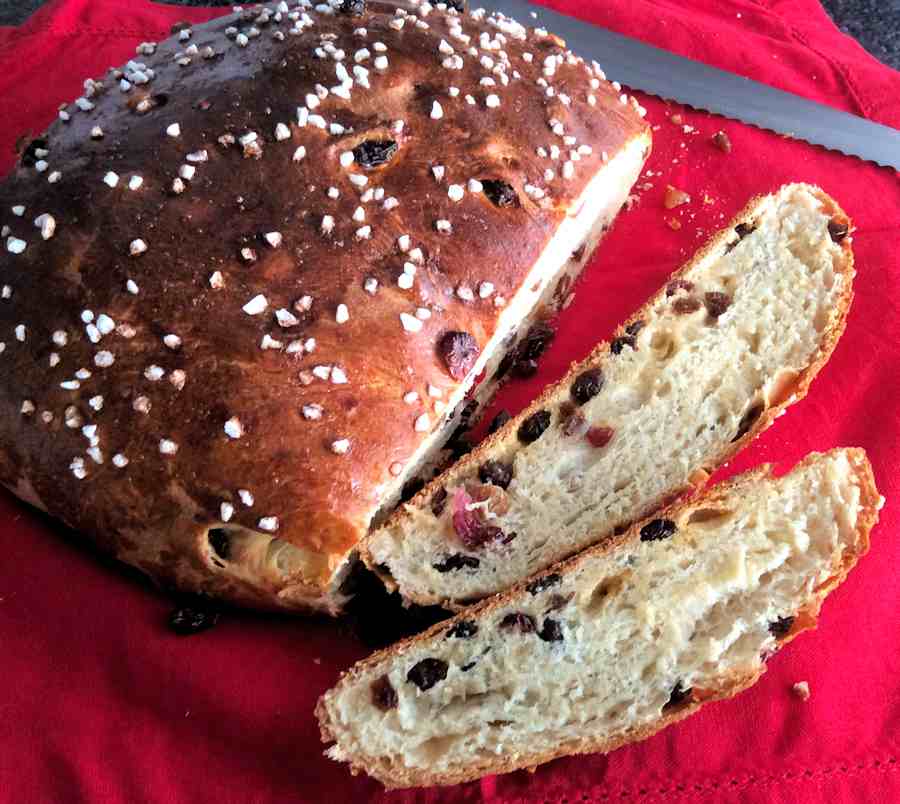Julekake means 'Christmas cake' and it's the traditional festive bread-cake in Norway at Yule(Jule)tide.

Christmas baking
Come December, there’s a lot of baking going on around the world. The most wonderful preparations are being mixed everywhere, dried and candied fruit spills over it like jewels and mounds of billowing dough rise and swell in warm kitchens.
There’s panettone and pandoro in Italy, Stollen in Germany, Three Kings Bread in Spanish-speaking countries and English Christmas cake.
Christmas cakes or Christmas breads?
With the exception of the English one, traditional Christmas cakes are of the bread type: yeast leavened, kneaded by hand or in standing mixers, baked in a hot oven. Why are they commonly called breads?
They are all cakes in their right: take Stollen, bursting with fruit, sticky with marzipan and double-coated in sugar. How is it possibly ‘bread’? It’s a cake, through and through.
You can’t even apply here the traditional explanation, that things baked in loaf tins are more likely to be called ‘breads’, i.e., banana or pumpkin bread. None of the above is loaf tin-shaped; in fact they all have their own, dedicated tins or cases.
But yeasted dough seems to be shunted into the ‘Bread’ drawer in England and France and even panettone gets to be called bread.
Scandinavian Christmas breads
Scandinavians bake with yeast for Christmas: the Swedes have their saffron buns, the Finnish – their festive (weird) bake, joululimppu and the Norwegians bake julekake.
What is julekake like?
In my view, it is the best thing for Christmas Day breakfast and even better on Boxing Day, toasted and thickly buttered. Julekake is better than a brioche: firmer and more substantial, and not so rich.
Arguably it is a little more like a bread than a cake, unlike panettone for instance, as it cuts into neat slices.
It’s not messy with marzipan like Stollen and more of a crowd pleaser, lacking the Marmite factor of joululimppu.
It is wholly recommended for those who want to try their hands at Christmas baking but don’t have the courage to tackle panettone.
Julekake is easy to make
The best things about it are a/ it’s silly easy to make, b/ it rises and doubles in volume obediently and c/ the cardamom fragrance.
It’s a diversion from the ubiquitous clove/nutmeg/cinnamon aroma permeating Christmas kitchens, fresh and heady. If it wasn’t for those tiny turd-like seeds being so awfully awkward to grind, I’d make everything cardamom-flavoured every day.
It’s made over about three hours so within a very reasonable timescale – compared to panettone which takes almost a week, including all the preparations!
This process if fairly standard: make a starter with yeast, then mix up main dough which is a doddle if you have a standing mixer, and not so very tough by hand either.
Rising in bulk (which means prepared dough before shaping or dividing) takes an hour. The shaping is easy, like shaping an enormous bun, which then in turn needs to rise for just over half an hour.
Egg wash glaze and a sprinkle of pearl or coarse sugar is the final touch – optional but a shame not to!
Jule-what?
I gather there is some discussion even among the Norwegians on whether it’s spelt julekake or julekaga but seeing as I’m not Norwegian I’ll leave it to natives.
What it reminds me most of is a glorious giant hot cross bun without the cross or one of the English teacakes, only better.
Vær så god og god jul!
More Norwegian recipes
Something for Christmas breakfast: cured salmon, homemade gravlax. It takes only three days to make and is more delicious than any shop-bought smoked salmon.
Boller, Norwegian buns with cardamom flavour are also worth a mention.
And they make this fantastic apple cake, eplekake, with lots of cinnamon and almond slivers.
More Christmas baking recipes
I could not mention panettone without pointing to the recipe: this one is for a slightly easier version, made with bakers’ yeast.
I bake my mother’s fruitcake every year, it’s lighter than the traditional English Christmas cake.
Or you can simply bake some mince pies – so much better than any bought in store.